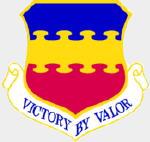Hobby Master HA2105 USAF North American F-100C Super Sabre Fighter - Wing Commander Col. George Laven Jr., 479th Tactical Fighter Wing (1:72 Scale)
"Television brought the brutality of war into the comfort of the living room. Vietnam was lost in the living rooms of America - not on the battlefields of Vietnam."
- Marshal McLuhan
 The North American F-100 Super Sabre was a jet fighter aircraft that served with the United States Air Force (USAF) from 1954 to 1971 and with the Air National Guard (ANG) until 1979. As the first of the Century Series collection of USAF jet fighters, it was the first of a series of US fighters capable of supersonic speed in level flight and made extensive use of titanium throughout the aircraft.
The North American F-100 Super Sabre was a jet fighter aircraft that served with the United States Air Force (USAF) from 1954 to 1971 and with the Air National Guard (ANG) until 1979. As the first of the Century Series collection of USAF jet fighters, it was the first of a series of US fighters capable of supersonic speed in level flight and made extensive use of titanium throughout the aircraft.
The F-100 was designed originally as a higher performance follow-on to the F-86 air superiority fighter. Adapted as a fighter bomber, the F-100 would be supplanted by the Mach 2 class F-105 Thunderchief for strike missions over North Vietnam. The F-100 flew extensively over South Vietnam as the Air Force's primary close air support jet until replaced by the more efficient subsonic A-7 Corsair II The F-100 also served in several NATO air forces and with other US allies. In its later life, it was often referred to as "the Hun," a shortened version of "one hundred."
In January 1951, North American Aviation delivered an unsolicited proposal for a supersonic day fighter to the United States Air Force. Named Sabre 45 because of its 45 degree wing sweep, it represented an evolution of the F-86 Sabre. The mockup was inspected on July 7th, 1951 and after over a hundred modifications, the new aircraft was accepted as the F-100 on November 30th, 1951. On January 3rd, 1952, the USAF ordered two prototypes followed by 23 F-100As in February and an additional 250 F-100As in August.
The YF-100A first flew on May 25th, 1953, seven months ahead of schedule. It reached Mach 1.05 in spite of being fitted with a de-rated XJ57-P-7 engine. The second prototype flew on October 14th, 1953, followed by the first production F-100A on October 9th, 1953. The USAF operational evaluation from November 1953 to December 1955 found the new fighter to have superior performance but declared it not ready for wide scale deployment due to various deficiencies in the design. These findings were subsequently confirmed during Project Hot Rod operational suitability tests. Particularly troubling was the yaw instability in certain regimes of flight which produced inertia coupling. The aircraft could develop a sudden yaw and roll which would happen too fast for the pilot to correct and would quickly overstress the aircraft structure to disintegration. It was under these conditions that North American's chief test pilot, George Welch, was killed while dive testing an early-production F-100A on October 12th, 1954. A related control problem stemmed from handling characteristics of the swept wing at high angles of attack. As the aircraft approached stall speeds, loss of lift on the tips of the wings caused a violent pitch-up.
Nevertheless, delays in the F-84F Thunderstreak program pushed the Tactical Air Command to order the raw F-100A into service. TAC also requested that future F-100s should be fighter-bombers with nuclear bomb capability.
The F-107 was a follow-on Mach 2 development of the F-100 with the air intake moved above and behind the cockpit. It was not developed in favor of the F-105 Thunderchief, which would become noted for its weaknesses in close in air combat.
Pictured here is a 1:72 scale replica of a USAF North American F-100C Super Sabre fighter that was piloted by Col. George Laven Jr., Wing Commander of the 479th Tactical Fighter Wing.
Sold Out!
Dimensions:
Wingspan: 6-1/2-inches
Length: 7-3/4-inches
Release Date: April 2009
 Historical Account: "Ravin" - The 479th Wing Commander Colonel George "Ravin" Laven Jr. selected a new F-100C for his personal aircraft. Its serial was 54-2076, the same last four digits of the P-38 he flew in 1942-43. In four years Colonel Laven logged over 2,000 hours and was the only military officer during that time to ever fly the aircraft. After several years the aircraft went to the New Mexico ANG who spent time in Vietnam. Upon returning to the US 2076 along with 91 other F-100Cs were sold to Turkey and flew until the early 1980;s.
Historical Account: "Ravin" - The 479th Wing Commander Colonel George "Ravin" Laven Jr. selected a new F-100C for his personal aircraft. Its serial was 54-2076, the same last four digits of the P-38 he flew in 1942-43. In four years Colonel Laven logged over 2,000 hours and was the only military officer during that time to ever fly the aircraft. After several years the aircraft went to the New Mexico ANG who spent time in Vietnam. Upon returning to the US 2076 along with 91 other F-100Cs were sold to Turkey and flew until the early 1980;s.


